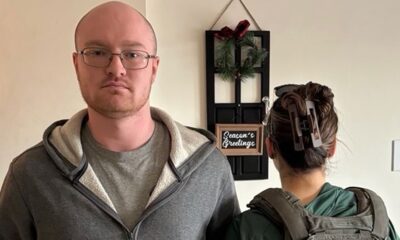Oklahoma
It's time to think differently about how we educate Oklahoma children. Community schools would help • Oklahoma Voice

Oklahoma’s dismal bottom 10 rank in education outcomes highlights a need to think differently about how we’re educating our children who continue to struggle with academic performance, chronic absenteeism and emotional and behavioral issues.
It’s time for our education leaders to take a hard look at the evidence-based benefits that come from increased investments in the community school model.
Community schools provide students with “wraparound services.” They focus on holistic approaches to educating children, understanding that for a child to thrive in school an integrated support system is also needed for their families at home. The model focuses on student and family engagement, collaborative leadership, enriched learning opportunities and integrated support systems.
Fortunately, in part by the pandemic and federal Covid funding, the Federation of American Scientists found that in 2023, “60% of public schools were utilizing a “community school” or “wraparound services model.” That was up from 45% the year prior.
If you think this model won’t work in a state that has an abundance of charter and private schools and is known for perpetually underfunding our public school systems, think again.
Tulsa Union is an example of an Oklahoma public school district that has successfully integrated the model. As one of the earliest adopters, the district received national attention for its student success.
Education expert, David Kirp, wrote in a New York Times opinion piece that contrary to the pressure to focus on rapid academic test score growth, former superintendent Cathy Burden understood that “focusing entirely on academics wasn’t enough, especially for poor kids.”
Instead, Union, which at the time reported 70% of students received free or reduced-price lunches, laid a foundation for meaningful learning by offering a “cornucopia of activities — art, music, science, sports, tutoring — that middle-class families routinely provide.”
Kirp wrote that the district opened its schools early. It helped families access health care. It worked to connect parents with job-training opportunities. It provided clothing, furniture and food to struggling students. It even offered daycare for teen mothers so they could graduate.
U.S. News and World Report now ranks Union High School as one of the nation’s top high schools. It is over 70% minority, and nearly 50% low-income, but it is basically tied with Oklahoma’s high schools for academic achievement.
Other districts have also experimented with the model.
In 2017, when a bus load of Oklahoma City partners visited Rosa Parks Elementary School, we toured their health center, the “Tinker Lab” for hands-on learning, and their organic gardens built around the theme of “Peace.” The key to success was teamwork. The students selected the crops they wanted to grow and built a kiln in the garden. A teacher created “Wind Wonders” to teach aeronautics.
My favorite story was about the Rosa Parks teacher who rushed out of the building, saying she had to go to Jiffy Lube. The teacher had been trying to track down a parent for a conference and she’d just learned that the mom was about to take her lunch break.
Drawing on Tulsa Union’s success, a scientific consensus, and the work of Linda Darling-Hammond’s Learning Policy Institute regarding the benefits of community schools, a grassroots movement created the David R. Lopez Community School at Edgemere.
Despite its great success, Oklahoma City School Public Schools shut it down during the implementation of its Pathway to Greatness plan.
In spite of that setback, I see the community school model as being one that could increase our academic outcomes by acknowledging a holistic model is needed for our children — and their families — to thrive in a post-pandemic landscape.
But in order to achieve greatness, we’d need visionary leadership. We need leaders who are patient enough to lay the groundwork today in hopes of netting substantial gains years down the road.
The model won’t succeed if our leaders are looking for a short-term, easy political victories and immediate results because wraparound services are more expensive and take considerable resources to get off the ground.
I’m hoping we have some visionary education leaders.
Because I don’t see a path forward for improving the academic and social outcomes for low-performing schools until we commit to implementing community schools statewide.
GET THE MORNING HEADLINES DELIVERED TO YOUR INBOX

Oklahoma
OKC Thunder Deploy Traditional Starting Lineup vs. Spurs

The Oklahoma City Thunder are taking on the San Antonio Spurs in the Semi Final of the 2025 NBA Cup tournament. This is the third year of the event and second straight trip for the OKC Thunder to the Semi Final.
This is set to be a barn burner, as the Oklahoma City Thunder enter this contest 24-1 and the San Antonio Spurs sit at 17-7. Though, the even better news for both sides is the injury report. The Spurs get back generational talent Victor Wembanyama from his multi-week stint on the injured list and the Isaiah Hartenstein returns for Oklahoma City after missing the Thunder’s last five games.
With Oklahoma City only missing Isaiah Joe (knee contusion) in this contest, it gives them a rare treat. The Thunder for the first time all season will have their fully healthy starting five at their disposal. Many believe Mark Daigneault will deploy superstar Shai Gilgeous-Alexander, Defensive ace Lu Dort, All NBA swingman Jalen Williams, Rising star Chet Holmgren and Hartenstein.
This was the first time all season the Thunder have had the chance to prove that thought process right. It can be hard to navigate such a talent filled roster especially as well as Cason Wallace played as a spot starter and leading the league in steals.
In the end, the Oklahoma City Thunder weren’t the ones to throw a curveball with the starting lineup. It was the San Antonio Spurs who will bring Victor Wembanyama off the bench according to the official injury report submitted to the league before tip off.
This makes sense as Wembanyama has missed three weeks of action with a calf strain. San Antonio head coach Mitch Johnson revealed that his star center was going to be restricted in his first game back, especially against this historically great defense.
OKC Thunder vs. San Antonio Spurs Starting Lineups
OKC Thunder Starters
- Shai Gilgeous-Alexander, G
- Lu Dort, G
- Jalen Williams, F
- Chet Holmgren, F
- Isaiah Hartenstein, C
San Antonio Spurs Starters
- De’Aaron Fox, G
- Steph Castle, G
- Devin Vassell, F
- Harrison Barnes, F
- Luke Kornet, C
The Oklahoma City Thunder will have to be mindful of their rotations to counter Wembanyama off the bench and stagger the likes of Holmgren and Hartenstein to counter it.
Up next, the Oklahoma City Thunder will either take on the New York Knicks on Tuesday in the NBA Cup Championship game with a win or resume their regular season with a loss. Falling to the Spurs would snap the Thunder’s 16 game winning streak, but issue Oklahoma City four days off leading into Thursday’s clash with the L.A. Clippers.
Oklahoma
Oklahoma WWII veteran, POW headed home for burial after 82 years

Catch up on Oklahoma’s top headlines of the week for Dec. 12, 2025
Here are Oklahoma’s top headlines of the week for Dec. 12, 2025
A Pawnee native who died in a Japanese prison during World War II is headed back to Oklahoma after officials identified his body 82 years later.
James M. Walker was an infantry corporal stationed on the Philippine Islands when Japan invaded in December 1941. U.S. forces battled the Japanese in intense fighting for months, but ultimately surrendered to the invaders in April 1942.
After being taken prisoner, Walker and thousands of other prisoners of war were forced to travel 65 miles to a prison camp on the notorious Bataan Death March. More than 2,500 POWs are reported to have died at the camp.
Prison camp records showed he died on Jan. 1, 1943 at the age of 46, but he was buried in a common grave with other deceased prisoners. After the war, the American Graves Registration Service exhumed the bodies, collected samples for identification analysis and reburied the remains in a memorial cemetery in Manila.
To identify Walker’s remains, scientists used dental and anthropological analysis, as well as circumstantial evidence. The Armed Forces Medical Examiner System also used mitochondrial DNA analysis and mitochondrial genome sequencing data.
Although interred as an “unknown” for decades, Walker’s grave was meticulously cared for by the American Battle Monuments Commission. His name is listed on the Walls of the Missing at the Manila American Cemetery and Memorial in the Philippines. A rosette will be placed next to his name to indicate his remains have been identified.
Upon his return to the United States, Walker will be buried in Maramec, Oklahoma in January 2026.
Oklahoma
Suspect in custody after deadly shooting in Oklahoma City following heated argument
OKLAHOMA CITY, (KOKH) — Oklahoma City police responded to a fatal shooting in the 2600 block of N. Kelly Friday evening.
According to OKCPD, the shooting occurred at around 6:20 p.m.
When officers arrived, they located one adult male with gunshot wounds at the scene. The victim was transported to a nearby hospital where he later died during surgery.
Police believe the shooting was a result of a verbal argument that escalated into a fistfight and then a shooting.
The suspect has been taken into custody and transported to police headquarters for questioning.
This is a developing story; please check back for updates.
For more local news delivered straight to your inbox, sign up for our daily newsletter by clicking here.
-

 Alaska1 week ago
Alaska1 week agoHowling Mat-Su winds leave thousands without power
-

 Texas1 week ago
Texas1 week agoTexas Tech football vs BYU live updates, start time, TV channel for Big 12 title
-
Ohio1 week ago
Who do the Ohio State Buckeyes hire as the next offensive coordinator?
-

 Washington5 days ago
Washington5 days agoLIVE UPDATES: Mudslide, road closures across Western Washington
-

 Iowa7 days ago
Iowa7 days agoMatt Campbell reportedly bringing longtime Iowa State staffer to Penn State as 1st hire
-

 Miami, FL7 days ago
Miami, FL7 days agoUrban Meyer, Brady Quinn get in heated exchange during Alabama, Notre Dame, Miami CFP discussion
-

 Cleveland, OH7 days ago
Cleveland, OH7 days agoMan shot, killed at downtown Cleveland nightclub: EMS
-
World6 days ago
Chiefs’ offensive line woes deepen as Wanya Morris exits with knee injury against Texans
























